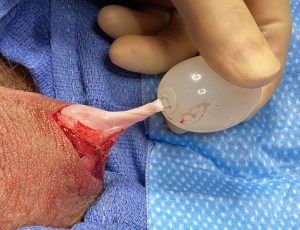The testicles are a unique anatomic structure in the scrotum. They are basically oblong firm structures that are suspended inside the scrotal tissues by a neuromuscular cord and enveloping fascia. Despite having an attached cord the testicles are relatively free floating which is a necessary feature given their location between the inner thighs.
The most common reason for testicle implants, historically and still today, is reconstructive in nature to replace a lost testicle. Many older implant styles were composed of a firmer solid silicone and today it is a silicone shell filled with saline. While neither of these implaut compositions feel like a normal testicle (too firm) the one technique that is similar in their placements is the use of suture fixation. The exact logic of suturing a testicle implant into place is not clear given that one of the features of the implant is that it should move freely. With such suture fixation often comes a high riding testicle, one that does not move and sometimes pain and palpability at the permanent suture location.

The exact need for using suture fixation of testicle implants is not clear since it seems contradictory to a freely mobile testicle. I suspect the logic of its use was to keep the testicle’s oblong shape in a more vertical orientation… which is how the testicle may sit being attached to its neurovascular cord. But unlike the natural cord, which is both mobile and able to be stretched a bit, suture fixation creates a firm and immobile testicle. This is not what I would do for either a primary or secondary testicle implant placement whether it be reconstructive or aesthetic in purpose.
Dr. Barry Eppley
Indianapolis, Indiana


